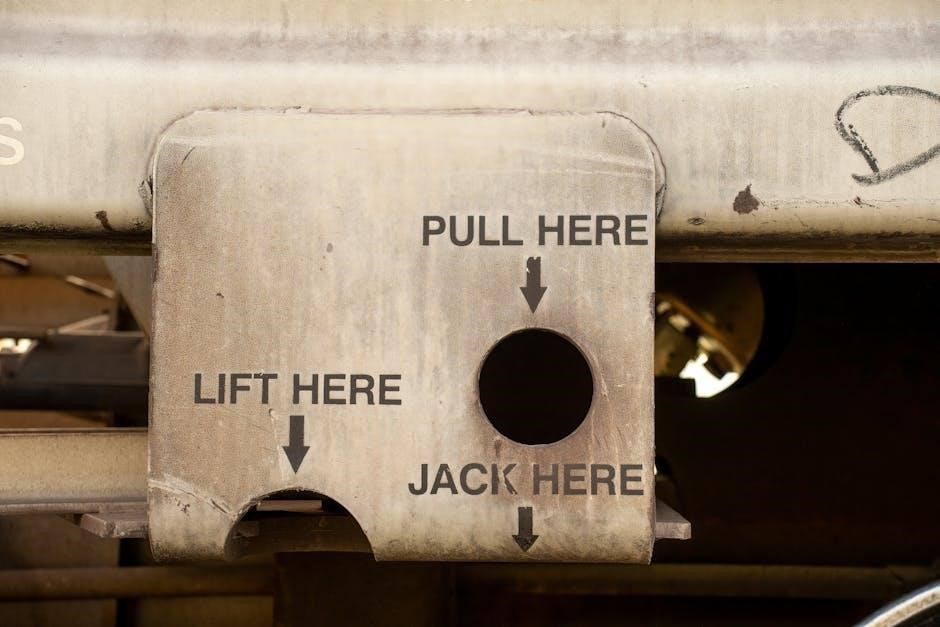Importance of Regular Forklift Inspections
Regular forklift inspections prevent accidents‚ ensure compliance with safety regulations‚ and reduce repair costs. They help identify potential issues early‚ prolonging equipment lifespan and ensuring a safer workplace environment.
Reducing Workplace Accidents
Regular forklift inspections significantly reduce workplace accidents by identifying mechanical issues early. Faulty brakes‚ worn tires‚ or hydraulic leaks can lead to severe incidents. Separating forklifts from foot traffic and ensuring proper training for operators are critical. According to OSHA guidelines‚ forklift-related accidents often result from poor maintenance or operator error. By addressing these factors‚ inspections help prevent collisions‚ tip-overs‚ and other hazards‚ fostering a safer work environment and reducing injury risks.
Ensuring Compliance with Safety Regulations
Regular forklift inspections ensure compliance with safety regulations by verifying that equipment meets OSHA guidelines and workplace standards. Employers must separate forklifts from foot traffic and provide proper training. Inspections help identify hazards‚ such as hydraulic leaks or faulty brakes‚ ensuring adherence to safety protocols. Compliance reduces legal risks and workplace accidents‚ promoting a safer environment. Following manufacturer instructions and safety guidelines is essential for maintaining regulatory standards and minimizing operational risks;

Prolonging Equipment Lifespan
Regular forklift inspections help extend equipment lifespan by identifying wear and tear early. Checking for hydraulic leaks‚ fluid levels‚ and tire condition prevents costly damage. Addressing issues like worn brakes or damaged forks avoids premature deterioration. Proper maintenance‚ as outlined in manufacturer guidelines‚ ensures components function optimally. By addressing minor problems before they escalate‚ inspections reduce downtime and extend the operational life of the forklift‚ making it a reliable asset for years to come.
Pre-Operation Forklift Inspection Checklist
Inspect tires‚ brakes‚ lights‚ and hydraulics before use. Check for damage‚ fluid levels‚ and proper functionality. Ensure all safety features work to prevent accidents and ensure smooth operation.
Tires and Wheels Condition
Inspect tires for wear‚ cuts‚ or bulges. Ensure wheels are securely attached and free from damage. Proper inflation is crucial for stability and load handling. Check for uneven wear‚ which may indicate misalignment. Damaged or worn tires can lead to loss of control‚ increasing accident risks. Always refer to the manufacturer’s guidelines for specific tire conditions and replacement criteria. Neglecting tire inspections can result in costly repairs or downtime‚ emphasizing the importance of thorough pre-operation checks to ensure safe and efficient forklift operation.
Brakes and Steering Functionality

Inspect brakes for proper function‚ checking for wear on brake pads and fluid levels. Ensure the steering system operates smoothly without play or damage. Test brake responsiveness and ensure the forklift stops evenly. Look for leaks in hydraulic lines connected to brakes and steering. Malfunctioning brakes or steering can lead to accidents‚ so thorough inspection is crucial. Always test the forklift by moving it slowly to confirm brakes and steering are functioning correctly before full operation. Regular checks help prevent incidents and ensure safe handling of loads.
Lights and Signals
Inspect the forklift’s lights and signals to ensure proper functionality. Check brake lights‚ turn signals‚ and warning beacons for visibility and operation. Verify that all lights are clean and free from damage. Test the horn and ensure it emits a clear‚ audible sound. Malfunctioning lights or signals can reduce visibility and communication‚ increasing accident risks. Always test these systems in a safe area before operation. Refer to the manual for specific guidelines on inspecting and maintaining lighting and signaling systems to ensure compliance with safety standards and regulations.
Hydraulic and Fluid Levels
Inspect hydraulic lines for leaks‚ damage‚ or wear. Check fluid levels using the dipstick or sight gauge‚ ensuring they meet manufacturer recommendations. Look for signs of contamination or discoloration. Proper hydraulic function is critical for lifting and lowering loads safely. Low fluid levels or leaks can lead to mechanical failure‚ causing accidents. Always refer to the forklift manual for specific fluid type and level requirements. Maintain a clean and well-lubricated system to ensure smooth operation and prevent costly repairs. Address any issues promptly to avoid downtime and safety risks.

Post-Operation Forklift Inspection
Post-operation inspections involve checking for hydraulic leaks‚ inspecting for physical damage‚ and ensuring attachments are secure. This ensures safety and prevents potential issues before the next use.

Checking for Hydraulic Leaks
Inspecting for hydraulic leaks is crucial to prevent fluid loss‚ which can lead to equipment failure. Look for signs of leakage around hoses‚ cylinders‚ and connections. Even minor drips can indicate worn seals or damaged components. If left unaddressed‚ hydraulic leaks can cause malfunctions‚ posing safety risks and increasing repair costs. Always refer to the forklift manual for guidance on inspecting hydraulic systems and addressing potential issues promptly to maintain operational safety and efficiency.
Inspecting for Physical Damage
Regularly inspecting for physical damage is essential to ensure forklift safety and functionality. Check the mast‚ forks‚ and overhead guard for dents‚ cracks‚ or wear. Look for loose or missing parts‚ such as bolts or guards‚ which can compromise stability. Damage to the frame or load-bearing components can lead to equipment failure‚ posing serious safety risks. Addressing physical damage promptly prevents accidents and ensures compliance with safety standards. Always consult the forklift manual for specific inspection and repair guidelines to maintain optimal performance and workplace safety.
Ensuring Proper Functionality of Attachments
Inspecting forklift attachments like clamps‚ lifters‚ or side-shifters is crucial for safe operation. Check for wear‚ damage‚ or misalignment that could affect performance. Ensure all attachments are securely fastened and functioning as intended. Refer to the forklift manual for specific guidance on attachment inspection and maintenance. Properly functioning attachments prevent load instability and reduce accident risks. Always test attachments under load before operational use to confirm reliability and safety compliance‚ ensuring a secure working environment for operators and nearby personnel. Regular checks help maintain efficiency and prevent costly repairs.

Reading and Understanding Forklift Manuals
Reading the manual ensures operators understand safety warnings‚ controls‚ and maintenance guidelines. It helps prevent accidents and ensures compliance with operational and safety standards effectively.
Safety Warnings and Precautions
Understanding safety warnings in the manual is critical to preventing accidents. Operators must be aware of specific hazards‚ such as equipment failure or tip-over risks. Adhering to precautions ensures safe operation‚ while ignoring them can lead to severe injuries or fatalities. OSHA guidelines emphasize the importance of following these warnings to minimize workplace risks. Regular inspections and proper maintenance‚ as outlined in the manual‚ further enhance safety. Always prioritize precautions to protect both operators and nearby personnel from potential dangers associated with forklift use.
Familiarizing with Controls and Instruments
Understanding the controls and instruments of a forklift is essential for safe and efficient operation. Reading the manual helps operators identify and comprehend each component’s function‚ ensuring proper usage. Familiarity with controls like levers‚ buttons‚ and gauges enables precise movements and load handling. Ignoring this step can lead to accidents or equipment damage. Regular inspection and manual review reinforce operator confidence and competence‚ minimizing risks during daily tasks. Proper control management is vital for maintaining workplace safety and operational efficiency.
Maintenance and Repair Guidelines
Regular maintenance ensures forklifts operate safely and efficiently. Operators must follow manufacturer instructions for routine checks and repairs. Addressing defects promptly prevents accidents and extends equipment lifespan. OSHA guidelines emphasize proper maintenance to reduce workplace hazards. Ignoring repair needs can lead to equipment failure‚ injuries‚ or fatalities. Always refer to the manual for specific maintenance schedules and procedures. Proper upkeep not only enhances safety but also optimizes performance and reduces long-term costs. Consistent adherence to maintenance guidelines is crucial for a safe and productive work environment.

Load Capacity and Stability
Exceeding load capacity risks instability and accidents. Always check the rated capacity and ensure even load distribution. Proper balance during operation is critical for safety and control.
Understanding Load Limits
Understanding load limits is crucial for safe forklift operation. Always check the data plate for the maximum weight capacity. Exceeding this limit can cause instability and accidents. Ensure loads are evenly distributed and securely positioned. Never overload‚ as it compromises safety and can damage the equipment. Refer to the manufacturer’s guidelines for specific load restrictions. Proper load management enhances stability and control‚ reducing the risk of incidents. Always prioritize load limits to maintain a safe working environment and prevent potential hazards.
Proper Load Distribution
Proper load distribution is essential for safe forklift operation. Always center loads on the forks to maintain balance and stability. Use pallets or securing devices to prevent shifting during movement. Avoid overhanging loads‚ as they can destabilize the forklift. Ensure the load is evenly distributed to prevent tipping. Check the forklift’s capacity and adjust loads accordingly. Improper distribution can lead to accidents and equipment damage. Refer to the manufacturer’s guidelines for specific load arrangement recommendations. Proper distribution ensures smooth operation and enhances workplace safety.
Maintaining Stability During Operation
Maintaining stability during forklift operation is critical for preventing accidents. Drive at safe speeds and avoid sudden turns or stops. Keep loads low to reduce the risk of tipping. Ensure proper load distribution and balance. Always check tire condition and fluid levels before operation. Use attachments correctly and follow weight limits. Be aware of uneven surfaces and obstacles. Adhere to OSHA guidelines and manufacturer instructions for stability. Poor stability can lead to accidents‚ injuries‚ and equipment damage‚ emphasizing the need for careful operation and regular inspections.
Forklift Safety Regulations and Standards
Forklift safety regulations emphasize OSHA guidelines‚ proper training‚ and separating forklifts from pedestrians. Employers must ensure compliance with these standards to minimize risks and accidents effectively.
OSHA Guidelines for Forklift Safety
OSHA requires operators to complete training and certification programs‚ ensuring they understand safety protocols. Pre-operation inspections are mandatory to identify hazards. Employers must separate forklifts from pedestrian traffic and enforce load capacity limits. Non-compliance can result in severe fines. OSHA guidelines also emphasize proper maintenance and regular equipment checks to prevent accidents. Employers must stay updated on regulations to ensure a safe workplace and reduce the risk of forklift-related injuries and fatalities‚ which account for nearly 100 deaths annually.
Workplace-Specific Safety Rules
Workplace-specific safety rules require employers to separate forklifts from pedestrian traffic and ensure load limits are strictly followed. Regular inspections and proper training are essential. Employers must enforce designated forklift paths and ensure operators adhere to speed limits. Non-compliance can lead to fines and accidents. These rules complement OSHA guidelines‚ ensuring a tailored approach to safety. Employers must also maintain records of inspections and training to demonstrate compliance and accountability‚ fostering a safer work environment and reducing risks associated with forklift operations.
Reporting Issues and Defects
Documenting inspection findings ensures transparency and accountability. Escalating critical defects promptly prevents accidents and downtime; Failing to act on issues can lead to severe safety and operational consequences.
Documenting Inspection Findings
Accurate documentation of forklift inspections is crucial for transparency and accountability. Detailed records‚ including dates‚ issues identified‚ and actions taken‚ ensure compliance with safety standards. Proper documentation helps track recurring problems‚ enabling proactive maintenance. Using checklists or digital tools streamlines the process‚ reducing errors. Failing to document findings can lead to oversight‚ increasing the risk of accidents and non-compliance. Regular audits of inspection records reinforce accountability and demonstrate a commitment to safety. This practice also aids in identifying training needs for operators and maintenance staff.
Escalating Critical Defects
Identifying and escalating critical defects during inspections is vital to prevent accidents and ensure operational safety. Operators must immediately report severe issues like hydraulic leaks or brake failures to supervisors. Delaying repairs can lead to equipment failure‚ injuries‚ or fatalities. A clear escalation process ensures timely maintenance and minimizes downtime. Proper documentation of defects and their resolution helps track patterns and improves overall safety protocols. Ignoring critical defects can result in legal liabilities and non-compliance with safety regulations‚ emphasizing the need for prompt action and accountability.

Training and Certification
Proper training and certification are essential for forklift operators‚ ensuring they understand equipment operation and safety protocols. Recurrent updates and refreshers are crucial for maintaining compliance and safety standards.
Operator Training Requirements
Operators must undergo comprehensive training to ensure safe forklift operation. This includes understanding safety protocols‚ equipment functionality‚ and load handling. Training emphasizes compliance with OSHA guidelines and workplace-specific rules. Operators are taught to inspect forklifts before use‚ identify potential hazards‚ and operate within load capacity limits. Proper training also covers emergency procedures and incident prevention. Regular updates and recertification are required to maintain proficiency and adapt to new safety standards. Adequate training reduces accidents and ensures operators can perform their duties safely and effectively in various work environments.

Recurrent Training and Updates
Recurrent training ensures operators stay updated on safety protocols and operational best practices. OSHA guidelines require refresher courses to address new equipment‚ workplace changes‚ and emerging safety concerns. These updates help operators maintain proficiency and adapt to evolving standards. Training covers inspection procedures‚ load handling‚ and emergency response. Regular updates also reinforce the importance of following safety regulations and reporting defects. Continuous learning fosters a culture of safety‚ reducing incidents and ensuring operators are well-prepared to handle their responsibilities effectively in a dynamic work environment.
Best Practices for Forklift Safety
Adopting a safety-first culture ensures compliance with regulations and reduces risks. Regular inspections‚ proper training‚ and adherence to load limits are critical for maintaining a safe workplace environment.

Encouraging a Safety-First Culture
Promoting a safety-first culture involves leadership commitment‚ employee engagement‚ and continuous training. Regular inspections and adherence to guidelines ensure a proactive approach to hazard prevention. Incentivizing safe behavior and fostering open communication encourage workers to prioritize safety. Employers should integrate safety protocols into daily operations‚ ensuring all staff understand their roles in maintaining a secure environment. By fostering accountability and awareness‚ organizations can significantly reduce risks and create a culture where safety is everyone’s responsibility‚ aligning with regulatory standards and best practices for forklift operations.
Continuous Improvement in Inspection Processes
Continuous improvement in forklift inspections involves regularly reviewing and refining processes to enhance efficiency and accuracy. By analyzing inspection findings‚ organizations can identify recurring issues and implement targeted solutions. Training programs should be updated to address common defects‚ and inspection checklists should be revised to reflect emerging safety standards. Encouraging feedback from operators and maintenance teams fosters a collaborative approach to improving inspection protocols. This iterative process ensures inspections remain effective and aligned with industry best practices‚ ultimately reducing risks and improving overall safety.
